Japanese Design Archive Survey
DESIGN ARCHIVE
Designers & Creators
Shigeru Uchida+ Uchida Design Inc. (Kiyoshi Hasebe)
Interior design
Date: 3 June 2019, 15:00 - 16:30
Location: Uchida Design Inc.
Interviewees: Kiyoshi Hasebe (Deputy Director), Reina Saga
Interviewers: Yasuko Seki, Aia Urakawa
Author: Aia Urakawa
PROFILE
Profile
Uchida Design Inc.
After the death of Shigeru Uchida in 2016, Kiyoshi Hasebe became Deputy Director of Uchida Design Inc. and developed projects such as the luxury residence "FLEUR PAVILIA" in Hong Kong, the hotel "ENSO ANGO" and "MIWA YUGAWARA". They also have ongoing product design projects such as furniture and watches, and have held exhibitions in Italy, Holland and Switzerland.
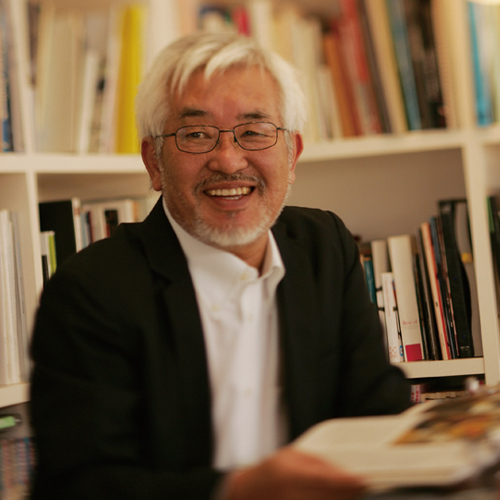
Description
Description
In June 2016, Shigeru Uchida spoke to us passionately about his thoughts on design journalism as well as the Design Archive. However, he passed away in November of the same year. Another major figure in Japanese interior design has left us.
After that, Uchida Design Inc has renewed its commitment and Kiyoshi Hasebe has taken over the role of Deputy Director, developing a wide range of projects including hotels, restaurants, offices and residences. After that, Kiyoshi Hasebe took over as the Deputy Director of Uchida Design Inc. with a renewed spirit. "In keeping with Uchida's vision and design philosophy, Uchida Design Inc. pursues a wide range of design possibilities, not only in interior design but also in architecture, furniture and products, regardless of genre. (omitted) We want to be an institute that challenges new approaches to design every day" (from the company website).
It is now two and a half years since Mr. Uchida died. The main purpose of this interview was twofold. The first is about what happened to the design archive on Mr. Uchida. The cycle of demolition is so rapid, especially in interior design, that the originals rarely survive, leaving only drawings and photographs. Perhaps that is why, unlike architecture, graphics or products, there are very few examples of design archives in museums or research institutions.
The second is to find out why Uchida Design Inc. has been able to carry on its activities, while most design firms that carry the name of a single individual disappear spontaneously after the death of the individual. Some designers with their own offices may be facing similar problems and are looking for a way forward.
This time we spoke to Hasebe, who has worked closely with Shigeru Uchida for many years and is now the driving force behind Uchida Design Inc.
Masterpiece
Representative works of Uchida Design Inc.
Interiors
ALTE MEISTER CA CENTER (2017); FLEUR PAVILIA (2018); ENSO ANGO (2018); SHIN TAMAGAWA ONSEN (2019); MIWA YUGAWARA (2019)
Exhibitions
WANDER FROM WITHIN (Italy 2017, Korea 2017, Japan 2018)
een hommage aan Mondriaan en Rietvelt door Shigeru Uchida (The Netherlands 2017)
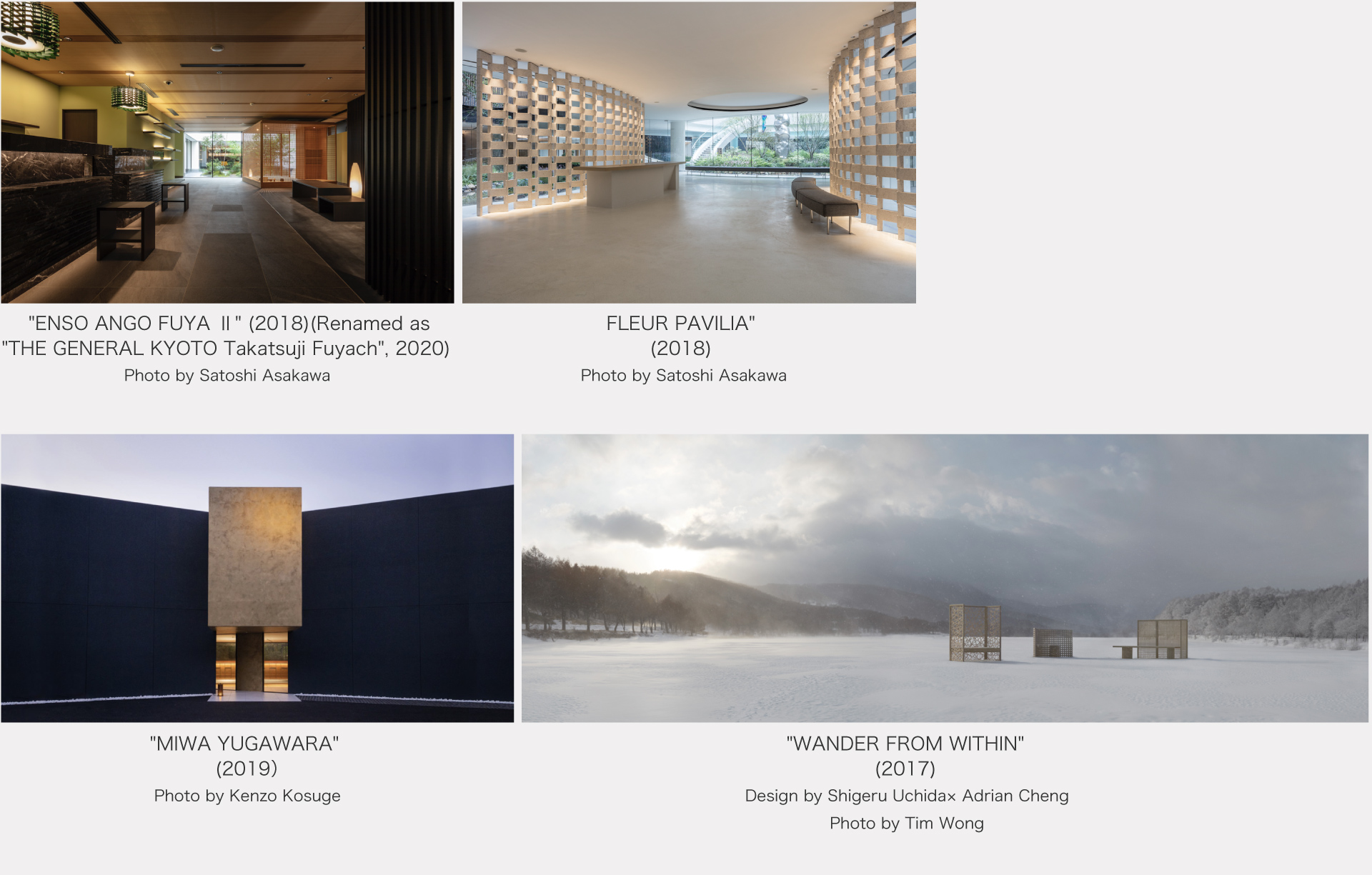
Interview
Interview
I suppose Uchida thought it worthwhile to leave institute to us after his own death.
After the archive as a thing.
― First of all, I would like to ask you about the archive as an object: what has been the state of affairs since the death of Mr. Uchida?
Hasebe Initially we wanted to donate them in bulk to any university or public institution that would be willing to store them semi-permanently. However, it was difficult to find a place for it in Japan, and when M+ in Hong Kong asked us to take over part of it, we decided to give it to them. Previously, everything was stored in a warehouse in Hachioji, but we have now moved to a warehouse with logistics services in Saitama. At that time, we disposed of damaged prototypes and other items, so what we have now is a complete collection, tearooms and old documents.
― What kind of work has been taken over by M+?
Hasebe The focus is on furniture, including some of his most famous works and drawings, such as the black pipe series of chairs from the 1970s, like "SEPTEMBER".
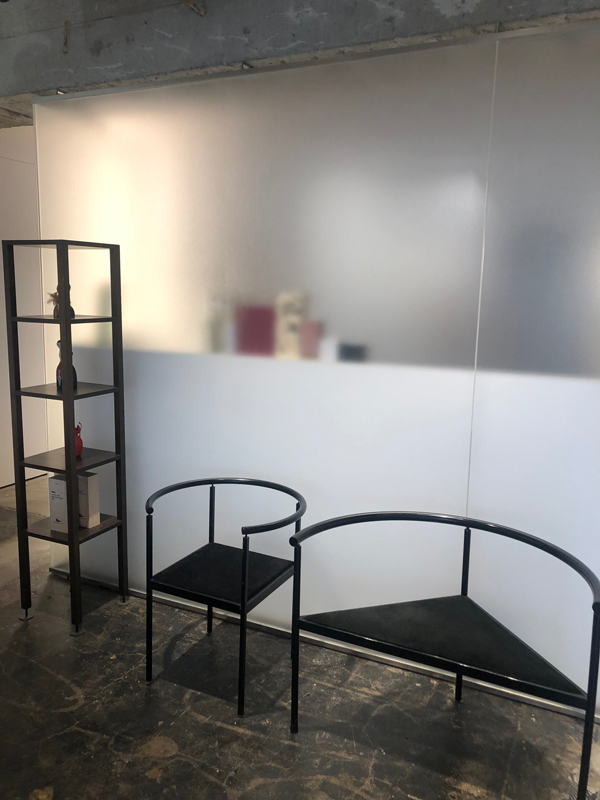
In the corner of Uchida Design Inc, you will find chairs and other objects designed by Uchida. "SEPTEMBER" on the right and "OCTOBER" on the left.
― Mr. Uchida has also designed tearooms, so he must have a lot of tea utensils.
Hasebe The wall storage in the meeting room contains tea utensils. Some are designed by Uchida and others by contemporary artists collected from all over the world. After Uchida's death, we moved to a new building, and we renovated the existing space and designed the storage space with the amount of tea utensils in mind. In fact, Uchida had about 5,000 books in his library, which he thought he couldn't bring, but ModuleX, a lighting company in Ebisu, took them all. Before his death, Uchida was very close to the former president, Mr. Nobuhiko Terumichi, and the current president, Mr. Goro Terumichi, often came to visit the institute from his childhood. Mr. Terumichi also loves books, and in 2016 he created a library in the corner of his head office, which was designed and renovated by Mr. Kengo Kuma. The books have been selected by Mr. Seigo Matsuoka. We also had a section for Uchida and Ikuyo Mitsuhashi. I also created a directory, which I visited several times and sorted by genre, such as what Uchida read when he was young, philosophy books, architecture and design. We usually borrow a few books from their library that we use frequently at work and keep them in the institute. I am relieved to say that we did not have to discard any of the books. The library is open to the public and can be borrowed.
― What is left now is mainly products like furniture. As for the archives related to space, do you have drawings, photographs or sketches?
Hasebe In addition to drawings, photographs and sketches, there are also a few models. There were some models of tearooms, but most of them have disappeared. In the world of architecture, it is common sense to keep models, for example by holding exhibitions of only models, but in the case of interiors, this idea is not so well established. All the photos are still there. Some of the film has been digitised, but there is still some positive film from the 1970s, which has yellowed considerably. The drawings are not 100% complete, but they are almost there. A retired member of the Institute once volunteered to organise it for us. There are more than 100 Yohji Yamamoto shops alone, and they put together drawings and documents for each project. However, we have only sorted out what was in pieces and have not yet archived it.
In the last 15 years of his life, Uchida began to make works that moved and changed with time, such as "Dancing Water", which he recorded on video. There was a man in Berlin who specialized in filming, and he was saving his films, but he passed away this year. We have DVDs and Blu-ray discs that have been edited for each exhibition or work, but I think the original data is still there in Berlin.
Uchida also thought the approach from the entrance to the back of the building was very important when designing the space, and we have recorded some of this in the video.
― At that time, did Mr. Uchida have a desire to leave his work as a record, an archive, for posterity?
Hasebe Perhaps he felt that a moving work could only be expressed in moving images, and that unless he documented it there, it would remain only in his mind and he would never be able to take it back. As for the photos, when Uchida made his debut, Mr. Shiro Kuramata told him that the shop would be gone in no time, so he should at least take some photos. Since then, Uchida has also started to take photographs. So we have all the photos. After that, I think his relationship with the photographer became closer and closer. I think that this is how photographers working in this genre have become established.
― In graphic design, there are institutions like Dai Nippon Printing, and in architecture, there are institutions like the National Archives of Modern Architecture. They don't exist now, but if you were to create something like that for interior design, what would be your ideal?
Hasebe As I mentioned in last interview, there are few institutions that will accept three-dimensional objects as they take up a lot of space and are not easy to manage, so we end up having to store them privately. Every designer who makes furniture or products has the same problem. As for the receptacles, they still need a lot of space, which is difficult to achieve unless they come with something like a warehouse.
21_21 DESIGN SIGHT does not currently have a collection of archives, but Mr. Issey Miyake had been calling for the need for a design archive even before this was created. I think that if there is more recognition of the social value of archives, public bodies and companies will start to think about them. I feel that one of the challenges is that it is not easy to organize design exhibitions in Japanese museums. Recently there are more and more people like nendo and we+ who are working in the area between art and design, and I think this kind of work is more accessible to people who usually look at art. Nowadays, the border between art and design is disappearing worldwide, and the value and view of design is starting to change little by little. If we move further in that direction in the future, there may be more momentum in Japan to do something about archiving. I think that the activities of NPOs such as yours, which are researching and documenting design archives and raising awareness, are also helping.
To inherit the institute.
― Our activity is now in its fourth year, and recently I have been thinking that no matter how much an object remains, if the designer who designed it is forgotten, it becomes a dead object. For art creators and painters, exhibitions and books are organised in the year of their death to remind us of their existence. In the case of design, a private practice can cease to exist when the person dies, and if someone wants to borrow a piece of work for an exhibition, or wants to talk to someone about it, they may not know who to contact. At Uchida Design Inc., Mr. Hasebe and your team have successfully taken over the project and inherited the spirit and mind of Mr. Uchida, which I think is a very rare case. How did you come to do this, and have you been preparing for this for years?
Hasebe While presenting his work as an individual design activity, Uchida was always thinking about the public interest: what kind of reputation and value the designs we work on will have in society, what kind of generation we will nurture, and how we will contribute to the world. He was somewhat of a big-brother type, so he felt he had to step up and do it. I think he had a sense of urgency and a sense of duty to help the industry as a whole to improve bottom-up, including incubation and education. The same goes for Uchida's desire to create a magazine, as he said in our last interview. He wanted to create a forum where people from all walks of life could come together to discuss and improve the dimension of design itself.
Because of this way of thinking, the name of the office was first "Uchida Design Office", but later Uchida, Mitsuhashi and I had many discussions and the name "Japan Institute of Design Culture" was chosen as a candidate. However, we felt that this was a little too grandiose and that it would be better if the designer's face could be seen, so we added Uchida's name and changed the name to "Uchida Design Inc." in 2002, as we thought it would be better to use "institute" rather than "office". When we think of institute, we think of voluntary prototyping for something of public interest, and this is exactly what we have done, reflecting our commitment to public interest and social activities other than the expression of our own work.
So, in view of this, I think that Uchida considered it worthwhile to leave the Institute to him after his death. As for taking over the institute, Uchida once asked me what I thought about it, but I didn't answer him properly. After Uchida's death, I had a lot of problems because I had so much to carry. I thought about dissolving the company, but I was afraid that things would get lost, and I thought that it would be important if everyone who is here now could continue to work together, and in the end none of the staff left, so I felt that I was pushed back.
― After Mr. Uchida's death, when you started the new institute, you had the option of taking his name from it, but why did you leave it?
Hasebe I think that Uchida's designs, for example, end after a generation of personal expression in the form of superficial shapes and habits. However, as the institute was originally founded by Uchida, and as he set the direction in which we are now heading, I thought it was only right to retain the name. At the end of the day, there is no one left to judge whether this is the right thing to do, but we are thinking about what Uchida wanted to say to society, and we aim to develop it into the next generation based on that. Apart from the two newcomers, all the other staff have worked with Uchida before. He used to go out for a drink with staff and talk about his ideas about design, and communicate with them a lot, so I think his spirit and mind has been passed on to them.
― Mr. Sori Yanagi's office is also not an organised business, but a foundation. I felt that we had one thing in common: design is not a personal expression, but a public one.
Hasebe I have never met Mr. Yanagi, but I think he felt the same way. As I mentioned earlier, Uchida was active in correcting the industry as a whole while pursuing his own personal expression, and since 2000 he has also been passionate about education. He was very keen to give something to young people, and worked as director of the Kuwasawa Design School and professor at Tokyo Zokei University. Whenever he gave a lecture, he would gather a lot of material on his own and study hard beforehand. Some of his handwritten texts and documents, which he speaks at that time, are still available.
He has also published a number of books on design. "Sengo Nihon dezainshi" (Misuzu Shobo, 2011) was published in China in 2018, and a Korean edition will be released this year. The choice of this book among his many other publications is probably due to the interest in the history of Japanese design in both China and Korea.
― That book feels realistic and convincing because, unlike those written by researchers and academics with an objective point of view, it is written by Mr. Uchida, a designer, based on his own experience. On a different note, when I visited Mr. Shin Matsunaga's office for this design archive, he told me that the space was designed by Ms. Ikuyo Mitsuhashi, Mr. Uchida's wife. What is the state of her archive?
Hasebe Mitsuhashi didn't make many products, so there are very few left. She retired in the nineties, partly because she was only active for a short time. All that's left is a photo of her old work. She was just so detailed and meticulous. She would arrange the pencils in the drawers in short order and spend three days cleaning at the end of the year. In the past, designers used to create elaborate designs for New Year's cards, which she filed away and collected. There are a lot of things that she received through these exchanges with other designers, and we keep them in a warehouse in Saitama with Uchida's things. Some of the New Year's cards and other items were brought back by relatives.
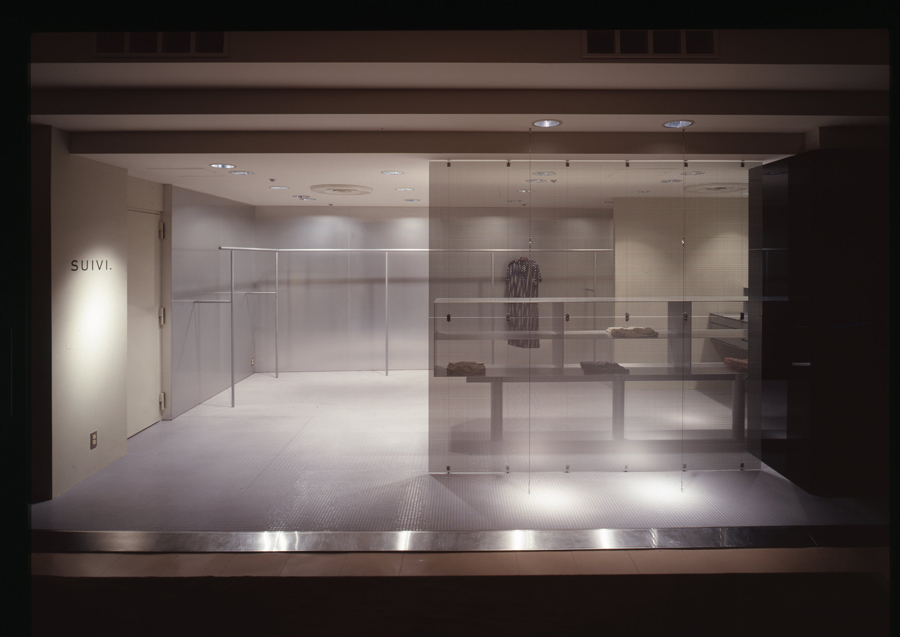
"SUIVI MATSUYA GINZA" (1986)
Design by Ikuyo Mitsuhashi
Photo by Nacása & Partners
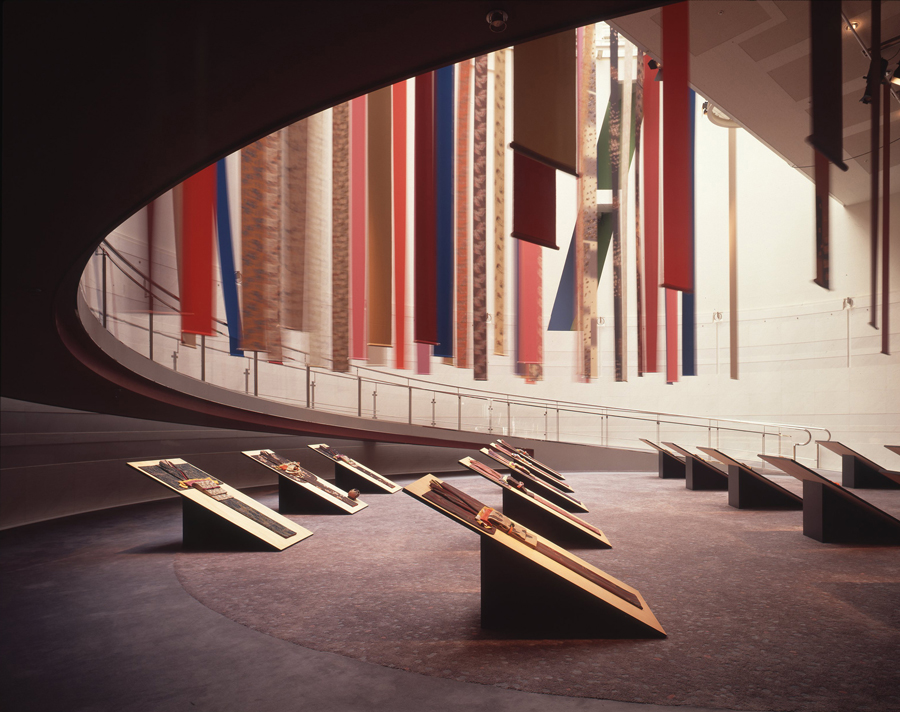
"BUSHOAN An Achievement of a Decade" (1987)
Design by Ikuyo Mitsuhashi
Photo by Nacása & Partners
Interior design changes with the times.
― Mr. Uchida used to work under the name Studio 80 before Uchida Design Inc.
Hasebe Studio 80 was originally set up by interior designer Mr. Toru Nishioka and Uchida. In the seventies they each had their own private office. In those days, private clients and designers would talk to each other about their dreams, aiming to create new and interesting shops and ideal houses. The client would say, "I'm going to build a bar", and the designer would say, "I'd like you to let me do it", and if they didn't have the money, "I'll get it from somewhere else". However, from the late seventies onwards, companies began to focus on the value of design and began to commission work on a corporate basis. So Mr. Nishioka and Uchida decided that designers needed to organise themselves and take a proper position in society, so they created Studio 80. About two years later, Mitsuhashi joined the team. Later, when the bubble economy burst and the turn of the century came, Uchida saw that the organisation had fulfilled its role and decided to return to its roots, leaving Studio 80 and moving into private practice. Studio 80 is still there, but not with us.
― Nowadays, the majority of interior design work is carried out by large organised companies, and the same applies to architecture, which is increasingly being handled by large general contractors and house builders. I was talking to a young designer recently and we were talking about how construction deadlines now take priority and they don't have the freedom to express themselves.
Hasebe In the seventies, individual clients and designers worked together on what they thought was interesting work, but in the eighties, due to the bubble economy, work on commercial facilities increased rapidly. Uchida was a little uncomfortable with the idea of a design that would disappear in a few years and be consumed. He criticised the interior design industry for being immersed in the cycle of commerce, and often said that it was "pathetic" to look at the trendy, fashion-conscious, and pretentious designs in the magazines of the time. I think he was trying to say that we should design things that will be loved for a long time, and that we should work in a more face-to-face relationship. Nowadays, design work is embedded in the on-the-business way things are done. The idea of cost-effectiveness and return on investment is important, but the numbers involved are difficult to include, so it is difficult to see the impact and meaningfulness of the wider unseen web of relationships. In other words, the value in the long run. In a situation where budgets and schedules are tight, young people who want to express themselves freely are now making their own products and holding their own exhibitions.
― On the other hand, the eighties were a time of great change in the world of interior design in Japan. Until the generation of Mr. Isamu Kenmochi and others, interior design was a part of architecture, like the design of a lobby inside a building, but I think it finally became independent in the generation of Mr. Uchida and Mr. Kuramata.
Hasebe I met Mr. Kuramata a few years before his death in his later years. His title was designer, but Uchida preferred to call himself an interior designer. I'm sure each of them had their own thoughts on why Mr. Kuramata chose the title designer and why Uchida called himself an interior designer. The word "designer" has a broad meaning, both in terms of the term and the area of work it encompasses, from art to design, with a wide range of possibilities. Uchida also worked in architecture, furniture, interior design and art, but his focus was on the idea of looking at things from the perspective of an interior designer and creating products.
― Nowadays, the number of designers who are featured in the media is increasing, not as a firm with a personal name, but as a firm that has created a brand, doing everything from interior design to architecture to products, and a wide range of genres.
Hasebe Today's young people come from a wide variety of backgrounds: if they are architects, they are coming into the interior design field because there are not as many jobs in architecture as they would like, or people who studied fashion are designing interiors. Even when someone other than an interior designer designs a space, the construction techniques in Japan are so advanced that even a rough sketch can be turned into a proper drawing and completed. I think it's partly because we're not good enough, but also because what the client wants is a new image, and it doesn't matter if you're not an interior designer or not, if you can come up with it.
In a way, it's a necessity of the times, and I don't think it's a bad thing. As people's interest in today's world expands from ornaments and clothes to furniture and space, it is not necessarily the case that only certain specialists are able to express themselves and work. If there is a problem there, is it the philosophy of manufacturing? It means that the experts have a specialised background.
The problem now is also how to produce the most efficient and effective products quickly and cheaply. You mentioned earlier that the construction period is prioritised, but it is assumed that the first step is to think about the number of years of return on investment, and this has become the norm. There is a lot of confusion about the tourism industry these days because it is being promoted so rapidly. This is why I think it is important for designers to be able to make proposals with a proper philosophy and not just follow trends.
― It is true that long, narrow, pencil-thin hotels are being built all over the back streets of Roppongi and Ginza, but I fear that they will turn into a wilderness when the fashion dies out. I get the impression that everyone is trying to make money.
Hasebe I think that the structure of the industry has to be based on tourism and culture, but at the moment culture is like a decoration to be consumed, and making money is the first priority. Perhaps we are divided into two groups: those who live in a world that could disappear tomorrow, and those who want to leave something behind through design. The book "Sengo Nihon dezainshi" is also linked to the major works of the period, and shows what values were valued and what messages were being sent out at that time. If a book of this kind is published again in 50 years' time, and I wonder whether our work will be worthy of being included in that book from 2010 to 2060, then we will know what we need to do.
― The main problem is that when you look back over the decades, things have gone from then on. It would be difficult to leave everything behind, so it is important to pass on at least the epochs to future generations. There are many firms that have continued to operate after the person’s death, such as SAKAKURA ASSOCIATES architects and engineer and MAYEKAWA ASSOCIATES, ARCHITECTS & ENGINEERS in the case of architecture, and perhaps as many as ten in the case of products and interiors, including Kenmochi Design Associates and Yanagi Design Institute. In this context, Uchida Design Inc. is now under the leadership of Mr. Hasebe, but there is also the question of how Mr. Uchida's work and the products of Uchida Design Inc. will be bequeathed to future generations 30 or 50 years from now.
Hasebe I think of it as a kind of experiment. If we experiment and find it's not right, we may stop there, or we may expand further. At this stage, I don't know.
We are currently working on a hotel project in Kyoto called "ENSO ANGO" (Renamed as "THE GENERAL KYOTO" in 2020), which was given to us a few months after Uchida's death, and this year we will be completing a couple more projects outside Kyoto. We are having an exhibition in Switzerland at the moment, and we are hoping to do more exhibitions in the future. Although we have not yet reached our full potential, we hope to continue to combine our design work with public interest and cultural activities.
― The exhibition at the Gallery le bain in Nishi-Azabu, which Mr. Uchida created in 2004, was a real public service and cultural activity.
Hasebe Gallery le bain was one of the ways in which we created a hub for people to come together. Now, again, in this digital age, I feel that it is very important to bring people together. I think it's important to have a place to meet new people, to communicate and to present your designs. Nowadays, there are more and more mini-galleries and shops, just like in the 70s. It's a world of eclectic tastes, and in a way it's an extension of subcultures, but in the old days, Otaku Culture were called "sukisha" or "monozuki". It's a place where people from all walks of life come together and interact, and a new world seems to be unfolding.
― I think that if you have a lot of these small pieces scattered like a mosaic, they can become one big force. Thank you for your time today.
Exhibition at Gallery le bain.
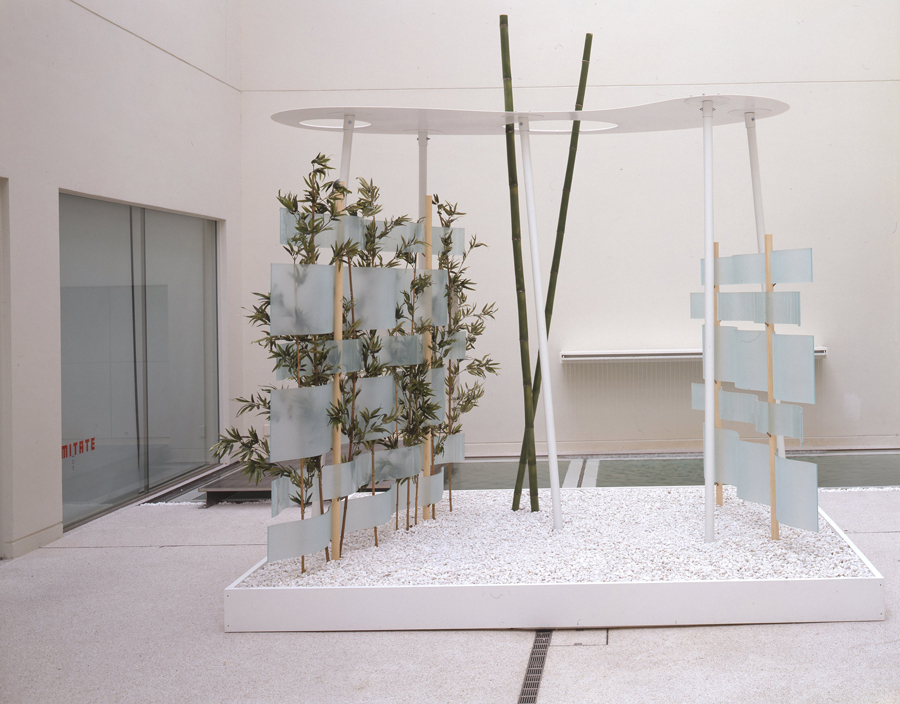
"Andrea Branzi×Shigeru Uchida MODERNITA DEBOLE Seeking for the Design of Weakness" (2005)
Photo by Satoshi Asakawa
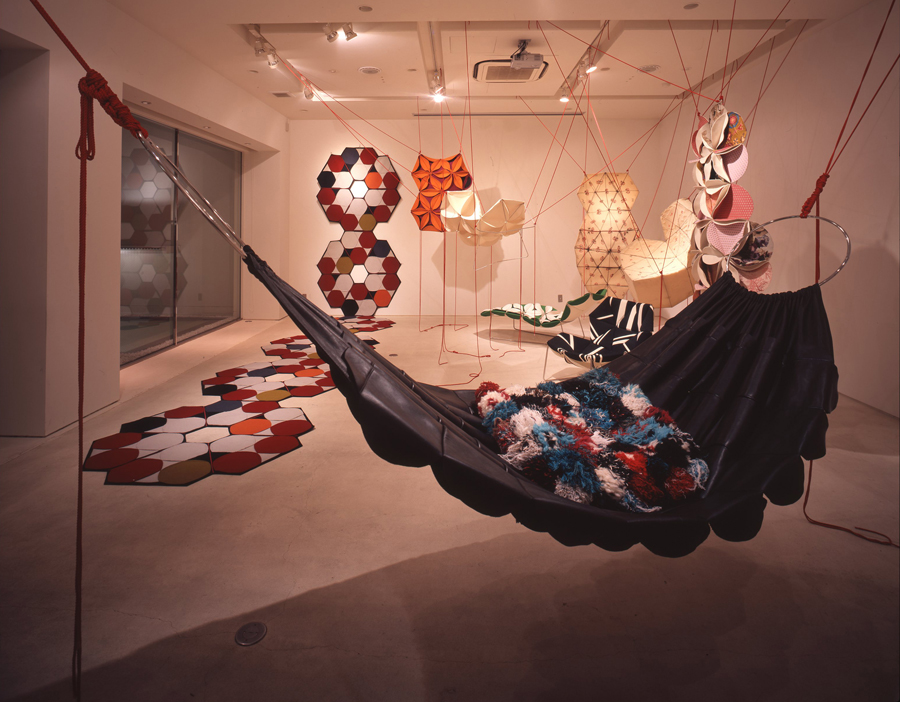
Exhibition "Johanna Grawunder+Patricia Urquiola" (2006)
Photo by Satoshi Asakawa
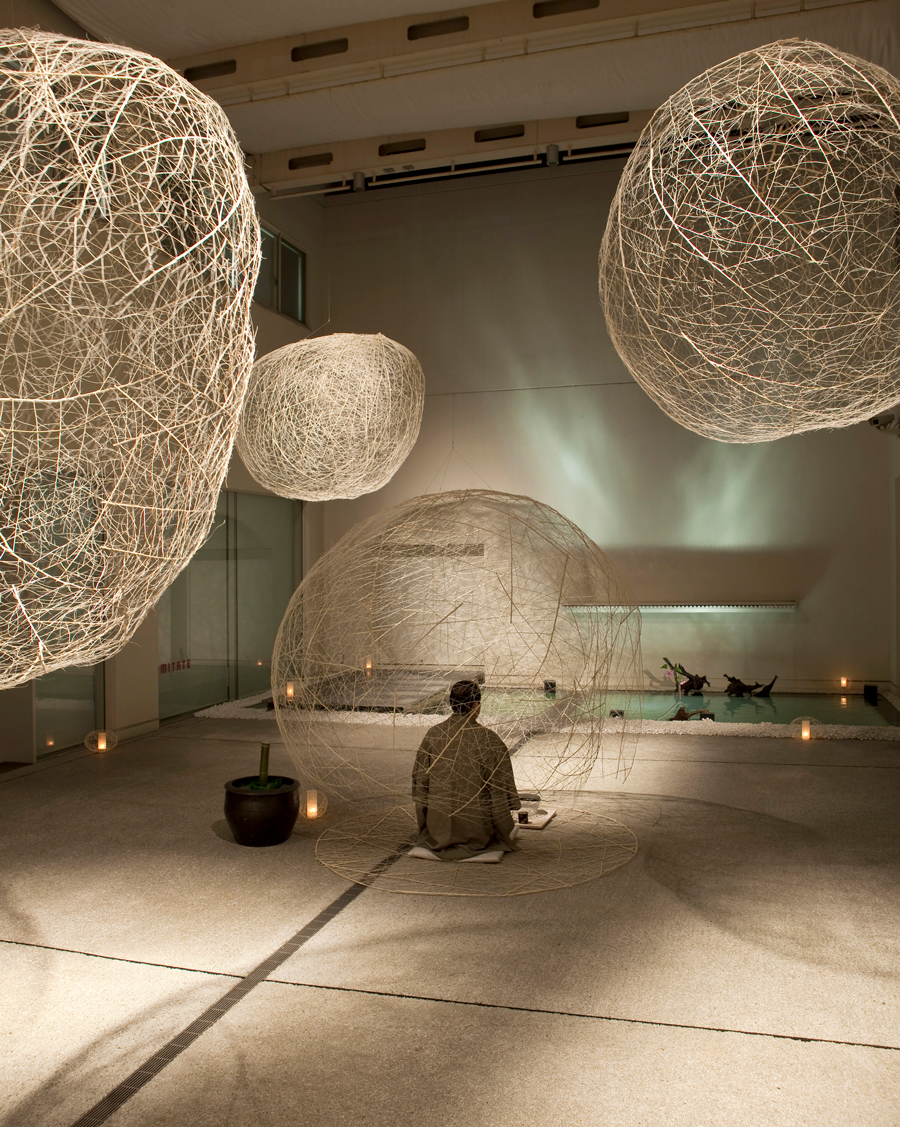
Kosen Yamada, Solo Exhibition "Kuu " (2010)
Photo by Kozo Sekiya
Enquiry:
Uchida Design Inc.
http://www.uchida-design.jp
Shigeru Uchida
Interior designer
Date: 13 June 2016 11:00 - 12:00
Location: Uchida Design Inc.
Interviewees: Shigeru Uchida, Kiyoshi Hasebe (Deputy Director), Reina Saga
Interviewers: Yasuko Seki, Aia Urakawa
Author: Aia Urakawa
PROFILE
Profile
Shigeru Uchida
Interior designer
1943 Born in Kanagawa.
1966 Graduated from Kuwasawa Design School.
1970 Uchida Design Office founded.
1981 Studio 80 founded.
2002 Company name changed from Uchida Design Office to Uchida Design Inc.
2016 He passed away.
(*He passed away in November 2016 after the interview.)

Description
Description
He has a wide range of activities in commercial and residential space, furniture, industrial design and community development, both nationally and internationally. Always keeping an eye on the times, he is active at the heart of the design world and continues to sincerely pursue the essence of design.
In the late 1960s, the Japanese interior design world saw a succession of rising stars, and Uchida emerged as a standard-bearer following on from the likes of Katsuki Iwabuchi, Takashi Sakaizawa and Shiro Kuramata. In the 1970s, when Japanese fashion designers were on the rise, interior designers also presented their own design spaces to the world. Uchida has created a series of boutiques for Yohji Yamamoto, which have been highly praised both at home and abroad as "contemporary Japanese spaces" deeply rooted in spirituality. In the 1980s, when the post-modern concept flourished, he created a wide variety of spaces, including restaurants, bars, hotels and shops. One of the masterpieces of this period is the HOTEL IL PALAZZO in Fukuoka with the Italian architect Aldo Rossi. The design of the hotel was carried out in collaboration with a variety of international designers, and the hotel was considered to be a pioneer in the field of "designer hotels", attracting attention from all over the world. In the nineties, he presented the folding tearoom "JI-AN SO-AN GYO-AN". The exhibition has toured to museums in Europe, showing the world the beauty of Japanese tradition. "GYO-AN" is included in the permanent collection of the Conran Foundation in the UK. Since the beginning of the 21st century in 2001, he has advocated "week modernity" (design for the sensory world of weakness) as opposed to the 20th century era of strength. The design of "L'UOVO", a striking light with a soft egg-shaped light, and " Moo", a chair inspired by an imaginary animal. In 2009 he held an exhibition in New York entitled "VAGUE HAZY TRANSPARENT WAVERING", in which he saw in the words of the theme something with which contemporary human beings can essentially connect. He is the author of many books and writes about the events he has seen and experienced first-hand. He was the director of his alma mater, the Kuwasawa Design School, from 2008 to 2011.
Masterpiece
Masterpiece
Interiors
Yohji Yamamoto (1986); Tsukuba Expo '85 Government Pavilion (1986); HOTEL IL PALAZZO (1989); Aoyama MIHONCHO (1989); KOBE FASHION MUSEUM (1997); ORIENTAL HOTEL HIROSHIMA (2006); THE GATE HOTEL Kaminarimon by HULIC (2012)
Products
Chair "September" (1977); Clock "DEAR MORRIS" (1989); Tearoom" JI-AN SO-AN GYO-AN" (1993); Lobby furniture "INTERIORSCAPE" (2003); Lighting "L'UOVO" (2004); Stool "Moo" (2005)
Books
"The Era of Chairs", Kobunsha (1988); "HOTEL IL PALAZZO - A City Stimulated by Architecture" , Rikuyosha (1990); "Japanese Interior Design - Its cultural Origin", Shobunsha (2000); "Tearoom and Interior", Kosakusha (2005); "Japanese Design Philosophies – Time, Space, Memory, Nature", Kosakusha (2007); "Design History in Postwar Japan", Misuzu Shobo (2011); etc.
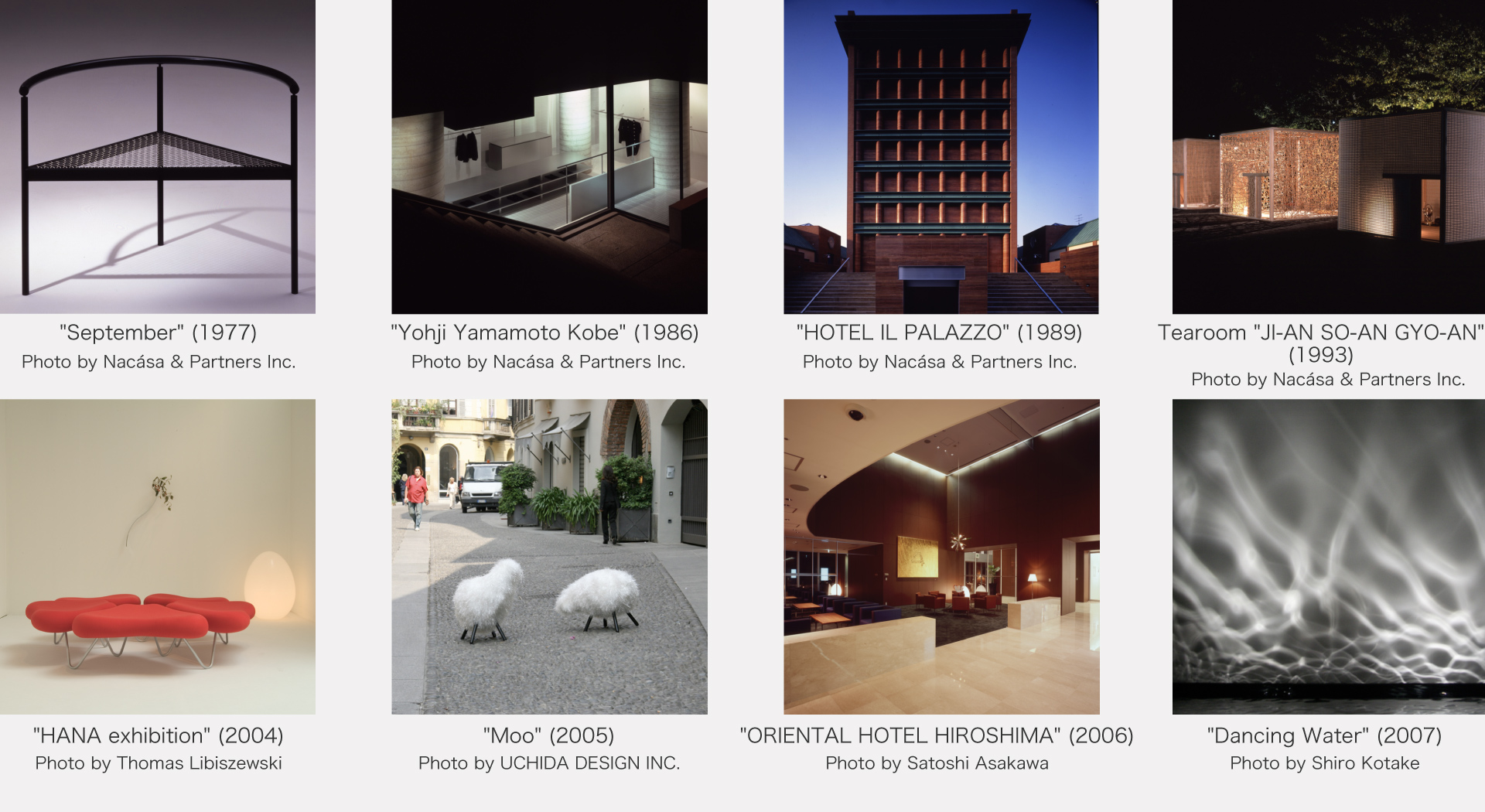
Interview
Interview
After all, putting together an archive is the most difficult thing to do. It's all about who puts it together.
Archive contents and where to store them.
― Many of the people who have shaped Japan's post-war design world are now old and some have even passed away. We would like to interview designers to find out how they are preserving their design archives and design footprints, and how they intend to do so in the future.
Uchida That's a good thing.
― Today I would like to ask you, Mr. Uchida, one of the leaders of the post-war design world, how you keep your archives and what you plan to do with them in the future. I know that you have a huge design archive, do you keep it somewhere now?
Hasebe We have a warehouse in Hachioji where we keep them. The representative work was bought by M + in Hong Kong.
― What are the various documents behind your work, such as idea sketches and drawings, not to mention the finished pieces?
Hasebe We have only taken some models, no studies (prototypes). We also do not have any kind of material samples for design resources. Idea sketches, drawings and prints are the main ones.
― Do you have a photo?
Hasebe We have all the photos. We have both digital and slides, and some of them are converted to digital. Slides dating back to the early seventies have become quite discoloured. I think anything from the late 70s onwards will be fine.
― Mr. Uchida has written many books, do you keep any books, magazines, handwritten manuscripts or text data?
Hasebe Most of our books and magazines are on the bookshelves in our office. There are some handwritten manuscripts, but little old text data remains. I think we have recent text data.
Thoughts on future publication of material.
― Do you just keep an archive of them? Or do you want to make it available to the public in the future?
Uchida The current situation is an interim measure, not a conclusion. Ultimately, we want it to be something that people from all walks of life can see. If there is a place in Japan where the archives are kept together, I would be happy to donate them to it.
― Yes, it is difficult for students to go to M+ in Hong Kong to see Mr.Uchida's work. What do you think about the possibility of universities and other educational institutions collecting the work of designers and artists with whom they have links?
Uchida I don't disagree with you about that, but I would like to see it taken care of collectively. I don't think it makes sense to take two or three things and collect them.
Hasebe I've been talking to Uchida for a while. I think that educational institutions like schools are good because it is less likely that the archives will be scattered and can be used for educational purposes. But, as Uchida says, I wonder what they can do with a couple of pieces of furniture in their possession. In my opinion, a certain amount is necessary.
― In Japan, there is still no place that can be called a design museum.
Uchida That's right.
― For a while, Mr. Issey Miyake was talking about building a design museum. As people who have been involved in design for many years, we started this project with the hope that it would be an opportunity to preserve the Japanese design archive for the next generation and to create a design museum in Japan.
Uchida That's a good thing. At that time, Mr. Miyake was very enthusiastic about talking to us. I also listened to the story with great interest.
What kind of design museum would be ideal?
― At the time, I think Mr. Miyake envisaged a large building in which to house the collection of archives. It is possible that the large building is divided into several smaller rooms, one for Mr. Uchida and one for Mr. Shiro Kuramata, and that each room displays the work of a different designer. However, in this day and age, it is difficult to build such a large building on a budget. For example, the offices of the designers are very nice, so I think it would be possible to turn them into a small museum and connect them in some way. Do you have any thoughts or ideas about what you would like to see in a design museum?
Uchida I don't know if it's suddenly said now, but I think it might be a good idea to have a few small rooms in a big building like you said, and to exhibit my stuff in one of them. I think it would be a good idea to discuss this with everyone, including what a design museum is. I think everyone around me has their own idea of what they want to make.
― The other day I asked Mr. Masayuki Kurokawa for his thoughts on the matter. He said that industrial design is fundamentally about the beauty of use, so it would not be interesting to see it just sitting on a display stand without moving.
Uchida It's all about the editing. It's the editing that matters.
― Yes, Mr. Kurokawa also said that it would be necessary to be creative in editing.
Uchida It's not just about putting the work there. If someone edits it well, I'm sure it will be of great value.
― As for graphic design archives, they seem to be stored in various places, such as universities, museums and printing houses. The difference with graphics is that three-dimensional objects such as furniture take up more space, which is not good for storage. What else can you tell us about the difficulties of leaving things as they are?
Uchida After all, editing the archive is the most difficult part of the process. It's about who edits it. Because there are quite a lot of problems. I think we all know how hard it is to find the right way to edit.
Hasebe Then again, at this stage, the way in which the archive is kept is probably not formulated.
― That's one of the problems.
Creating a magazine that captures the times we live in.
― We have just started this activity and we would like to hear your suggestions and opinions if you think we should do something like this too.
Uchida It's best to do it as soon as possible.
Hasebe Organising the archives is certainly something that we may need to do now. I feel that there are a lot of things that are going to be too late.
Uchida Because now I know that there are many people around me who have archives. I wrote this book ("Sengo Nihon dezainshi", Misuzu Shobo) because I felt I had to write about it now. In fact, last year I approached a number of publishers to see if they could help me with a magazine, but they said it was difficult to produce a new magazine at the moment.
― What kind of magazine do you envisage?
Uchida It is a magazine that expresses the very essence of its time. It is something that can be seen not only in words, but also as a visual and as a work. Design events are quickly forgotten by the public in the course of time. I knew I couldn't just leave it there, so I made a note of it anyway. This book was also written on the basis of those notes. For example, MATSUYA GINZA has held various important exhibitions at the turning points of time. In particular, "From Space to Environment" in 1966 was a very good exhibition. Creators from various disciplines such as painting, sculpture, photography, design, architecture and music created their works under the theme of "deconstructing the field of design". The works were arranged in relation to each other. The works, which changed when touched by hand, were an unprecedented form of visitor participation and raised a number of questions about people and the environment, design and people's lives. The 1968 problem was also a very important event in the history of design. It was a turning point in an era that saw the transition from an industrialised to an information society, as a wave of anti-establishment ideology spontaneously sprang up around the world. The Radicalism movement in Italy took this further and made it visible through design. There's a lot of that going on in the design world. There are many more things that are not such a big event.
It is important to preserve the idea of design.
― In the magazine that you want to create, for example, if the World Design Conference was held now, you would not only introduce the event, but you would also provide information about what the issues were and what design could do to address them.
Uchida That's right. I think it's important to go one step further and make it more in-depth. In retrospect, I regret that I did not go deeper into the fusion of interior design and fashion design in the 1970s. At that time, interior designers and fashion designers worked together to create new spaces, such as Mr. Shiro Kuramata and Mr. Issey Miyake, Mr. Takao Kawazaki and Ms. Rei Kawakubo, and myself and Mr. Yohji Yamamoto. How did such a phenomenon come about? It's not just about how beautiful or glamorous it was as a fashion statement, but why it was necessary to create such a space and what society wanted from it. Space is a manifestation of society's needs. I'd like to see a magazine that covers all these things. Nowadays, a magazine is no longer a magazine. That's not to say that the old magazines weren't great, but at least they were more in tune with the times than today's magazines.
― In that sense, in the 70's and 80's, there was a kind of ideology among designers, and some clients were willing to accept that. Nowadays we are in a market-oriented situation, where making money is the most important value, and things like ideology and commitment are excluded.
Uchida What was wrong, I think, was that at a time when we had to leave a lot of things behind as ideas, no one did anything. For example, the TOKYO DESIGNERS SPACE. A group of leading Japanese designers of the time, from all walks of life, formed an association and created a gallery. It started in 1976 and lasted for about 20 years. There have been various exhibitions, which I think have been the very essence of the idea, but in the end they have just been a bunch of people getting together and making noise. I can't help but feel that the same thing has been going on ever since, leading to the present day.
― Nowadays it is difficult for magazines to be established and the publishing industry is struggling. We all don't need to buy magazines to get information because it's right there on the internet. So I think that if we are going to make a magazine now, it has to be something that sets something completely different in motion and, as you say, it is important to keep a proper record of what is happening on the ground now. In the past, many movements have emerged from magazines. Maybe we can set those things up again from the perspective of the current times. Thank you very much for your time today. We are planning to launch a website in the summer.
Uchida That's good. This is very important and I will help you in any way I can, so please do.
Enquiry:
Uchida Design Inc.
http://www.uchida-design.jp

